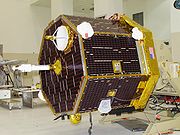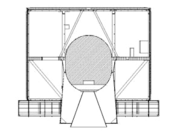
CONTOUR
Encyclopedia

NASA
The National Aeronautics and Space Administration is the agency of the United States government that is responsible for the nation's civilian space program and for aeronautics and aerospace research...
Discovery-class
Discovery Program
NASA's Discovery Program is a series of lower-cost, highly-focused American scientific space missions that are exploring the Solar System. It was founded in 1992 to implement then-NASA Administrator Daniel S. Goldin's vision of "faster, better, cheaper" planetary missions...
space probe
Space probe
A robotic spacecraft is a spacecraft with no humans on board, that is usually under telerobotic control. A robotic spacecraft designed to make scientific research measurements is often called a space probe. Many space missions are more suited to telerobotic rather than crewed operation, due to...
that failed shortly after its July 2002 launch. It had as its primary objective close flybys of two comet
Comet
A comet is an icy small Solar System body that, when close enough to the Sun, displays a visible coma and sometimes also a tail. These phenomena are both due to the effects of solar radiation and the solar wind upon the nucleus of the comet...
nuclei with the possibility of a flyby of a third known comet or an as-yet-undiscovered comet.
The two comets scheduled to be visited were Encke
Comet Encke
Comet Encke or Encke's Comet is a periodic comet that completes an orbit of the Sun once every three years — the shortest period of any known comet...
and Schwassmann-Wachmann-3, and the third target was d'Arrest
6P/d'Arrest
6P/d'Arrest is a periodic comet in our Solar System, orbiting between Mars and Jupiter. It passed 53 Gm from the Earth, about a third of the Earth-Sun distance, on August 9, 2008....
. It was hoped that a new comet would have been discovered in the inner solar system between 2006 and 2008, in which case the spacecraft trajectory would have been changed if possible to rendezvous with the new comet. Scientific objectives included imaging the nuclei at resolutions of 4m, performing spectral mapping of the nuclei at resolutions of 100–200m, and obtaining detailed compositional data
Compositional data
In statistics, compositional data are quantitative descriptions of the parts of some whole, conveying exclusively relative information.This definition, given by John Aitchison has several consequences:...
on gas and dust in the near-nucleus environment, with the goal of improving knowledge of the characteristics of comet nuclei.
After ignition on 15 August 2002 of the solid rocket motor intended to inject the spacecraft into solar orbit, contact with the probe could not be re-established. Ground-based telescopes later found three objects along the course of the satellite, leading to the speculation that it had been destroyed. Attempts to contact the probe were ended on 20 December 2002. The probe thus accomplished none of its primary scientific objectives, but did prove out some technologies such as the APL-developed non-coherent spacecraft navigation technique, which is now used on the New Horizons
New Horizons
New Horizons is a NASA robotic spacecraft mission currently en route to the dwarf planet Pluto. It is expected to be the first spacecraft to fly by and study Pluto and its moons, Charon, Nix, Hydra and S/2011 P 1. Its estimated arrival date at the Pluto-Charon system is July 14th, 2015...
spacecraft.
Spacecraft design

Hydrazine
Hydrazine is an inorganic compound with the formula N2H4. It is a colourless flammable liquid with an ammonia-like odor. Hydrazine is highly toxic and dangerously unstable unless handled in solution. Approximately 260,000 tons are manufactured annually...
fuel and a Star 30BP booster with a mass of 377 kg. Power was provided by a body-mounted solar array designed for operation at distances between 0.75 and 1.5 AU
Astronomical unit
An astronomical unit is a unit of length equal to about or approximately the mean Earth–Sun distance....
from the Sun
Sun
The Sun is the star at the center of the Solar System. It is almost perfectly spherical and consists of hot plasma interwoven with magnetic fields...
. It was three-axis stabilized for encounters and spin-stabilized during cruise mode between encounters.
COUNTOUR's Command/Data-handling and Guidance/Control computers both used the Mongoose V microprocessor. Communications were through a fixed 0.45 m diameter high-gain antenna designed to support data rates greater than 100 kbit/s at encounters. Data and images were stored on two 3.3 Gbit solid-state recorders with a capacity of 600 images.
The spacecraft was equipped with four primary science instruments: the Contour Remote Imager/Spectrograph (CRISP), the Contour Aft Imager (CAI), the Dust Analyzer (CIDA), and the Neutral Gas Ion Mass Spectrometer (NGIMS).
Mission
CONTOUR launched on a Delta 7425 (a Delta II Lite launch vehicle with four strap-on solid-rocket boosters and a Star 27 third stage) on July 3, 2002 at 6:47:41 UT (2:47:41 a.m. EDT) from Cape Canaveral Air Force StationCape Canaveral Air Force Station
Cape Canaveral Air Force Station is an installation of the United States Air Force Space Command's 45th Space Wing, headquartered at nearby Patrick Air Force Base. Located on Cape Canaveral in the state of Florida, CCAFS is the primary launch head of America's Eastern Range with four launch pads...
. It was launched into a high-apogee Earth orbit with a period of 5.5 days. Following a series of phasing orbits, the Star 30 solid rocket motor was used to perform an injection maneuver on August 15, 2002 to put CONTOUR in the proper trajectory for an Earth flyby in August 2003 followed by an encounter with comet Encke on 12 November 2003 at a distance of 100 to 160 km and a flyby speed of 28.2 km/s, 1.07 AU from the Sun and 0.27 AU from Earth. During the maneuver the probe was lost.
Three more Earth flybys would have followed, in August 2004, February 2005, and February 2006. On 18 June 2006, CONTOUR would have encountered comet Schwassmann-Wachmann-3 at 14 km/s, 0.95 AU from the Sun and 0.33 AU from Earth. Two more Earth flybys were scheduled in February 2007 and 2008, and a flyby of comet d'Arrest might have occurred on 16 August 2008 at a relative velocity of 11.8 km/s, 1.35 AU from the Sun and 0.36 AU from Earth. All flybys would have had a closest encounter distance of about 100 km and would have occurred near the period of maximum activity for each comet. After the comet Encke encounter, CONTOUR might have been retargeted towards a new comet if one was discovered with the desired characteristics (e.g. active, brighter than absolute magnitude
Absolute magnitude
Absolute magnitude is the measure of a celestial object's intrinsic brightness. it is also the apparent magnitude a star would have if it were 32.6 light years away from Earth...
10, perihelion within 1.5 AU).

